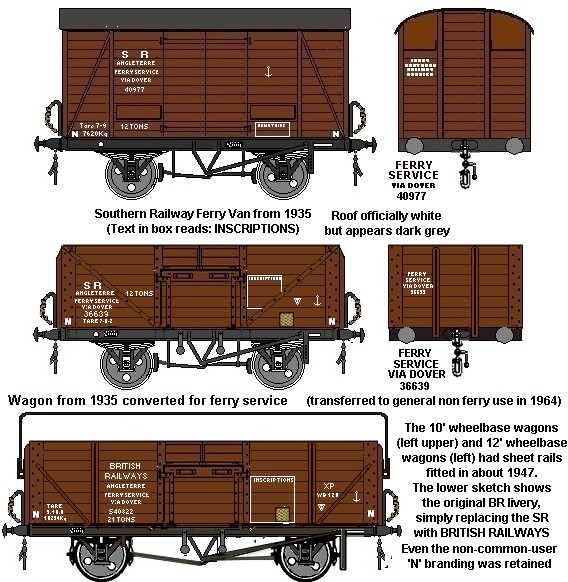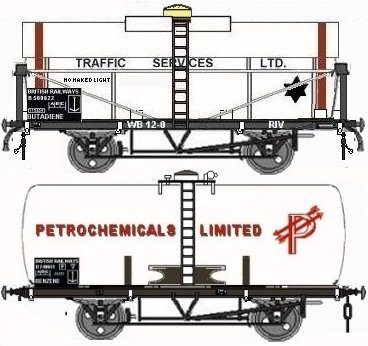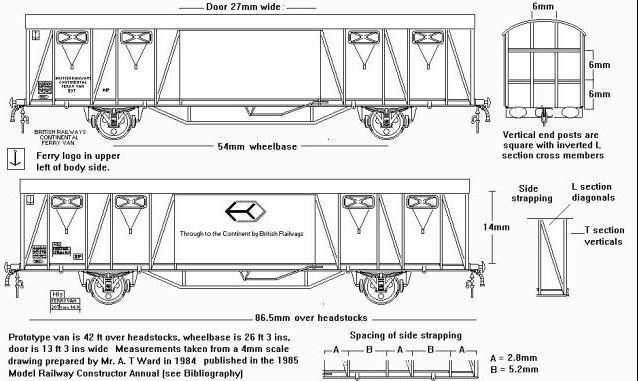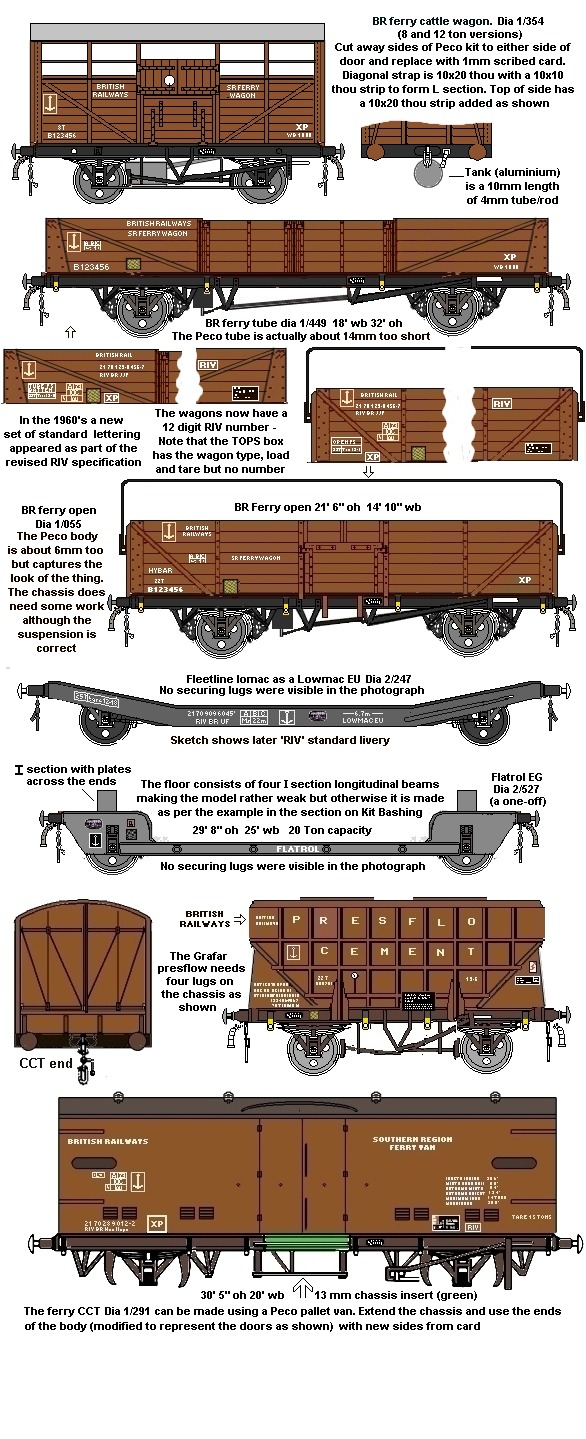Ferry Wagons
NB The colours used were obtained by sampling colour pictures, they
may however vary from the true colour, use as a rough guide only
During the First World War the military built three ships and hired a
fourth to carry railway vehicles across the channel to support the front. The
ships had stern ramps allowing the wagons to be rolled on and off the ship. Two
routes were used, Richborough to Calais and Southampton to Dieppe. This was not
a completely new idea as there were several such ferries operating in Europe
and in Britain the Forth Bridge had replaced a railway wagon ferry.
Following the war, in 1923, the Great Eastern Railway and a Belgian railway
company purchased the shore terminal equipment from Richborough (which was
prone to silting up) and established a service from Harwich to Zeebrugge in
Belgium. Three ships were used for the service (I believe these were the ships
built during the War by the War Department). Both the British and Belgian
companies purchased war surplus rolling stock and standard Belgian railway
wagons and vans were also used.
Most ferry traffic was imports from the continent
into Britain and the rules required stock to be quickly returned to the owning
administration so Continental registered stock always predominated. There were
a number of European railway company and PO vehicles which worked across to
Britain and once ashore these could wander far and wide, making these vehicles
of particular interest from modelling point of view.
I believe the war surplus wagons may have included
standard British open wagons fitted with a peaked roof, extended buffers and screw-link couplings (a standard WD design) but I could be wrong on that. The Great Central Railway built a number of their standard steel underframed six plank open wagons for service in France, fitted with extended buffers and screw link coupings but the only photo I have found (in Peter Tatlow's book on LNER wagons, see Bibliography) shows a wagon with no brake hoses and no apparent securing lugs for ferry operations. I have to date been unable to find any further details of the British rolling stock used, although I gather 'ordinary' British stock was used as well, however I understand the bulk of the rolling stock used was Continental. Continental stock is too big for the clearances in Britain so specially built stock was built for the ferry services. By the 1930s (possibly earlier) the German railways operated a number of wagons and vans built to suit the British loading gauge for use on ferry services to the UK. The vans, coded Gfh by the Germans, ran on a 23 feet wheelbase chassis with a body 35 feet long and (at least some) had the 'caboose' brake man's compartment added to one end. Quite a few of these large vans ended up in Britain when the Second World War broke out and were used for military services during the war, apparently some retained the Nazi logo on the side. German 'stake wagons' (four wheeled flat wagons with fold down side bars coded Rfh) were also produced for ferry work but non ended up in the UK during the war. These had a similar sized chassis to the vans and again (at least some) had the 'caboose' for the brake man at one end.
Ferry stock has
to be equipped to an internationally agreed standard, European railways used
the air brake whereas the British used vacuum brakes, but the European screw
link coupling could be used with a British coupling hook (British built stock
had the buffers packed out as the European coupling was longer than its British
counterpart). The British ex war department stock was air brake only but as far
as I am aware the GER/LNER stock used consisted of a few ex war department open wagons and vans. Later
British ferry stock was often fitted with a vacuum brake and either dual braked or
air piped. By the 1930's an anchor in a rectangle was the international symbol
for ferry stock, later this simply indicated that the vehicle could fit within
an internationally agreed loading gauge.
I wasn't able to find any details of the ex military rolling stock used, I enquired on the uk.rec.models.rail news group and it seems no one has seen published details of these vehicles. Brian Williams was able to advise . . .
Prior to the nationalisation of French Railways in 1938, both the PLM and
Midi ,which served the fruit producing areas of the south, built ventilated
ferry vans on what I believe to have been a 4m wheelbase underframe- these
stayed in use until the late 1950s at least, before being replaced by the
first generation of SNCF wagons. Some of these wagons may still exist as
service vehicles. The Italians also contributed vans, which had a shorter
wheelbase with apex roofs. Even more obscure were some 6 wheel Hungarian
wagons designed to carry live sturgeon- presumably mainly for the large
pre-war Jewish population in East London. One of these wagons found itself
the subject of a diplomatic incident at the beginning of WW2, as the
Hungarians were considered to be a non-belligerent nation, and wanted their
wagon back. In the end, they accepted £10 for it, though quite how they got
the money, I don't know..
Brian
Gregory Procton was able to advise on stock suitable for an OO scale layout . . .
In HO, the Piko model is a good representation, and the Roco and Liliput models
can be shortened by two panels to match. For OO, Rivarossi made vans in 1:80
scale. All those need re lettering with bi-lingual signage and the anchor logo.
Lima made a horrible HO low side wagon with offset brakesmans cabin with two
containers which are excellent models of the ice cooled fruit/vegetable
containers used for export to Britain etc from the mid 1920s until the post war
period. It was sold in numerous liveries including BR(!) The containers I have
were labeled 'Mercedes Benz' and 'Agfa'(?) but should be either white or silver
with "FS" and a number. (Oh for coloured photos from the 1920s ;-)
In the 1960's a new
international standard for ferry stock was introduced called RIV, all vehicles
that comply must have RIV displayed on each side of the vehicle. This standard
involves the type of coupling fitted and the provision of heavy lugs on the
chassis solebars which are used for securing the wagon to the deck of the ship.
Until BR changed over to air brakes ferry stock had to have both air and vacuum
brakes or 'through pipes' to cope with the national differences in brake
systems (as far as I know only some RIV Continental stock was fitted with a
through vacuum pipe). Wagons which have been partially modified for ferry work
do not carry the RIV branding but they should have an anchor in a frame painted
on the side to indicate they have no loading gauge restrictions. Ferry stock
was all fitted with screw couplings and until the 1980's the buffers used were
heavier than the British standard designs, they also carry non-standard
lettering and a 12 digit international ferry wagon number in place of the usual
national number marking as described in the section on Livery - Ferry Stock.
Continental railway company rolling stock meeting the RIV standard and
licensed to operate into the UK in the 1980's included vehicles from France,
Belgium, Spain, Portugal, Germany, Sweden, Czechoslovakia, Italy and Yugoslavia
totaling about a thousand wagons and vans. Interfrigo, a company jointly
established in 1950 by several European railways including BR, operated a fleet
of refrigerated vans mostly carrying meat and vegetables. These wagons used
(water) ice for refrigeration and possibly the longest regular ferry wagon
journey from Britain was Feta cheese (made in Scotland) carried to Iran in
Interfrigo vans. One slightly unusual British working was an Interfrigo van
hired by expatriate Italians to import grapes from Italy for home wine making.
Private owner stock is a regular feature of international operations
and the Spanish firm Transfesa were amongst the first to use the service in the
1920's. They employ vans with interchangeable axles as the Iberian railways use
five foot gauge. Other firms operating RIV stock include the British Traffic
Services Ltd (later part of the Belgian CAIB) and the German firms VTG (who
operated a lot of tanks and more recently the telescopic vans) and Cargowaggon
(who's van formed the basis for the BR VGA vans). The Swiss company Ermefer ran
bogie RIV tanks carrying bulk wine.
Much of the ferry traffic has
always been carried in vans but BR and continental open wagons have also been
used. I believe the most common foreign open in the post war era has been the
low sided 'stake' wagon but metal bodied French and Belgian wagons have also
been regular visitors, often covered by tarpaulin sheets (rather neatly roped
down in the photographs I have seen). Chemical traffic has been a feature of
ferry traffic since the 1950's, however most of the tank wagons used have been
supplied by Continental Private Owners. There are a number of suitable
continental vehicles available in the continental model ranges and suggestions
for suitable models have been included in the section on Available Models -
Continental Models. Some of the private owner stock suitable for ferry traffic
is discussed in the following section.
Information on the pre-world
war two ferry vehicles seen in Britain is hard to find, I have not found any
published references to the GER or LNER stock used on these services, although
I did find a GER poster on the Internet bearing a painting showing a rear view
of the ferry in the 1920's with what look like fairly standard albeit long
wheelbase British vans loaded on board. I gather the SR stock is covered in SR
Wagons Vol.4 and the BR stock in An Illustrated History of BR Wagons Vol 1 (see
Bibliography - I have both on order).
In 1937 the Southern Railway
established a service between Dover and Dunkirk (France). John Isherwood of
Cambridge Custom Transfers advises that they had three types of vehicle adapted
for ferry use - SR Diagram 1387 FERRY OPEN derived from their standard eight
plank Dia.1379, itself derived from an LSWR design. This can be modelled using
the Peco long wheelbase Tarpaulin wagon, see Goods Rolling Stock Design - The
Body. The same basic design was later produced as a longer twelve foot
wheelbase version dia 1388 FERRY OPEN which was fitted with a hinged tarpaulin
rail. The SR built a number of ferry vans to dia 1430 FERRY VAN, a modified
version of their Dia.1428 standard van, this was the droop-roofed type
originating with the SECR. As far as I can see the 'modification' to these
pre-war vehicles was limited to fitting a slightly different screw couplings,
packing out the buffers to suit this longer coupling and adding an air-pipe,
many of the early British vehicles do not appear to have the securing lugs on
the chassis.
As noted above British railway company rolling stock has
always been less common on the ferry trade. The LNER and SR stock modified for
the service but other vehicles were I understand cleared for ferry use on an
individual basis to carry specific loads.
Fig ___ Pre war British
Railway Company Ferry Vehicles

They
later built a twelve foot wheelbase version of this wagon and in the 1950's the
same basic design was built on a fourteen feet wheelbase chassis by BR. This
last is the subject of the Peco tarpaulin wagon model, which is pretty close to
scale. Because of the constraints of the British loading gauge larger loads are
handled on British rolling stock, generally owned by the British railways.
British Railways began building a small fleet of ferry wagons in 1950,
the first were tanks for ethylene oxide to dia 1/304 leased by Petrochemicals
Ltd which later became Traffic Services Ltd, these had a sun shield added in 1952 (below upper in later 1950s livery), followed by chemical tanks to dia 1/305 which again they leased to Petrochemicals
Ltd (below lower, original livery).
Fig ___ British Railways Ferry Tanks

Both these tank wagons, and an ICI operated arcton (refrigerant) ferry tank are illustrated and described in the section on 'Kit Bashing' in the subsection 'K Various types of unusual tank wagons'.
The large bogie latex tank wagons built for Henry Diaper of
Liverpool to dia 1/300 were built to ferry specifications but I have no
information on the routes they were used for. These bogie vehicles are more fully discussed in the section on Goods Rolling Stock Design - Rail Tanks.
Perhaps the most impressive investment by British Railways was the fleet of
four hundred long wheelbase four wheeled vans of rather continental appearance
introduced in 1962. The design was a success and further examples built over
the following two years until a total of about five hundred and fifty vans was
in service. They received the TOPS code VIX and remained in international (as well as domestic) traffic into the 1980s. Sketches showing the various liveries for these vans will be found
in the section on Livery - Ferry Stock. Some were converted for British Leyland motor car engine traffic (as described and illustrated in the section on Air braked wagon development). Hornby offered the van in OO scale and an N Gauge kit of this van is now available from Mill Lane Sidings (see Available Models - Kits). The kit uses a card box for the body with paper overlays and runs on a modified Peco 15 foot wheelbase chassis (this will probablhy restrict the minimum radius curves the model can handle).
Fig ___ British Railways Ferry Van

There was a very good
article written on the rolling stock seen on ferry services by Paul Bartlett
and Trevor Mann in the Model Railway Constructor Annual for 1985 (published by
Ian Allen Ltd 1984, ISBN 0 7110 1409 4). That article also listed all the BR
built rolling stock that rated full RIV classification.
The Peco long
wheelbase 'tarpaulin wagon' is a British Railways Southern Region ferry wagon
to dia 1/055, a total of thirty were built in 1957/58 and the Peco 'tube' wagon
is another ferry design, dia 1/449 dating from 1959, of which twenty were
built. In 1958 British Railways delivered some forty four wheeled 'Carfit C'
wagons to VIR specification for motor car exports. I think these were dia 1/092
and there is a photograph in Dave Larkin's Working Wagons Vol 2 but I cannot
confirm the wheelbase or length over headstocks, (they look about twenty five
feet long but I could be wrong). I believe these supplemented some ex Southern
Railway Carfit S four wheeled wagons already in use for Morris motor car
exports. A sketch of the Carfit S will be found in the section on Railway
Freight Operations - Road Vehicles, Military Traffic and Farm Machinery. There
were also a number of converted SR coach underframes coded Carflat and used for
motor car exports but I have not found any photographs of these. They were
unusual as BR did not use SR underframes for carlfats used internally. BR also
built some was curious double-deck car carrying wagons also known as the
Tierwag for MAT transport, they were used for exports of BMC cars but proved
difficult to maintain and were withdrawn after a short time.
To
transport commercial vehicles and larger items British Railways built a number
of ferry equipped end loading 'Lowmac' wagons to an LNER design. The Lowmac SF had a wheelbase of twenty two
feet and the Lowmac EAC had a wheelbase of twenty six feet. The Lowmac EU was
similar to the SF but was unfitted, having only an air pipe. The sketch below
is based on the old Fleetline N Gauge model which looked about right to me.
British Railways also built about thirty side-loading four wheeled drop centre
wagons for ferry work. The example shown below was a one-off, the Flatrol EG,
built in 1959 and was not to full RIV specification (although it was passed for
ferry work). The sketch was made from a photograph in Don Rowlands book on BR
wagons (see bibliography). This could be made as the LMS wagon shown in the
section on Kit Bashing although the end supports were H section steel rather
than timber and there was no floor. If modelling this wagon adding the
longitudinal support beams would be essential for strength although they were
not carried when Don's photo was taken. The 'Flatrol SBC' were thirty two feet
long with a twenty six foot wheelbase and a twenty one foot well in the centre,
the 'Flatrol EAC' was thirty three feet nine inches over headstocks but the
wheelbase was only twenty four feet and the well was only eighteen feet four
inches long. Both these wagons were equipped with longitudinal beams to support
the loads they carried.
Two impressively large twelve wheeler bogie
weltrol wagons were built for very large loads. The Weltrol EJ, capable of
lifting fifty five tons, was just over seventy one feet long with a thirty two
foot long well in the centre. As with the Flatrols the two wagons had
longitudinal beams to help to support loads.
There were also a number
of partial conversions of standard British Railways vehicles, modified for
ferry work but not to the full RIV ferry specification. This latter group
includes a number of vehicles fitted with securing lugs but lacking the full
air brake. There were several wagon types involved, one example being twelve
British Railways standard cattle wagons were fitted with securing points and
with a tank added underneath to collect urine. Built for working from Dover to
Dunkerque these seem to have had little use in Britain. In 1958 British
Railways modified some Presflo wagons (as available from Graham Farish) for
ferry work but although fitted with securing points and an air pipe for ferry
use they did not carry all the usual RIV markings.
Variations on the standard British
Railways four wheeled CCT and bogie GUV vans for ferry use were also built in
1958. There were a total of about thirty CCT's and only three GUV's and both
were rather different from the Lima and Graham Farish models. The ferry CCT was
shorter than the later standard design and had no windows and only one pair of
side doors, the ferry GUV was the same size as the British Railways standard
design but differed in having no windows and only two pairs of side doors. Both
the ferry CCT and ferry GUV were painted in standard freight stock livery, the
GUV might be modelled using a Graham Farish GUV but the livery would be
difficult as I know of no source for 'ferry' markings. Bernard Taylor described
the modifications required to a Lima CCT in an article on ferry wagons in
Practical Model Railways (see bibliography) but this did require extensive
surgery. A rather easier alternative is to use a Peco pallet van extended by
10mm, this is illustrated in the section on Livery - Ferry Stock.
The liveries shown below are to
some extent guess work although I gather photographs of the SR liveries are
shown in SR Wagons Vol. 4 and the BR liveries are shown in An Illustrated
History of BR Wagons Vol.1 (see bibliography for details). I do not (yet)
possess either of these books so I cannot comment further. The CCT van livery
is taken from a photograph and is interesting in that it has the earlier
'British Railways' branding but also the 12 digit RIV number more usually
associated with vehicles marked British Rail.
Fig ___ British
Railways Ferry Vehicles

There were also a small number of Freightliner container flats modified for use
on the ferry services, fitted with securing
lugs so they could be lashed down on the ferry. These ran a regular service to
France in the 1970's but I do not know how the rakes of conflats were set up, a
standard Freightliner five wagon set is about three hundred feet long, which I
think was longer than the deck of the ferry (I could be wrong on that, I
couldn't find the lengths of the ferry ships listed). There are photographs of
these wagons on Paul Bartlets website (http://gallery6801.fotopic.net/ - An
excellent site and highly recommended). These show a three wagon rake, two
outer vehicles with a bufferless inner between them. Two outers could also be
coupled together. This makes for an unusual 'Freightliner' working. The only
modifications required are the securing links on the chassis, the 'ferry'
identification plate and some other markings.
Fig___ Ferry equipped Freightliner flats

Some ex-Warflat
wagons that had been converted for steel coil traffic as Coil I were further
modified for ferry use as Coil K and coded JIX under TOPS. These wagons had two
nylon hoods to protect the coils in transit and were used on in the 1980's to
carry strip coil from British Steel being exported to Yugoslavia. When not
required for these duties they worked with other similar but unmodified
vehicles for normal internal British traffic. These wagons already had air
brakes fitted and only required the securing lugs to be added to the chassis,
they did not carry full RIV markings.
Sketches of several of the BR ferry
vehicles have been included in the section on Livery - Ferry Stock.
^
Go to top of page
International Good Guys ~ Exploding the Myth
since 1971 ~ Site maintained by 
All
material Copyright © Mike Smith 2003 unless otherwise credited




